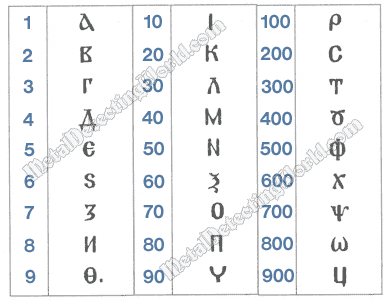How To Identify and Interpret Cyrillic Dates on Russian Coins of Peter I The Great
Helpful Tutorial for Coin Collectors - Part 2, page 4
(...CONTINUED from previous page)
Identification of Each Cyrillic Numeral in a Date
2) Identify Each Symbol - a Cyrillic Letter (Numeral) in a Date
Just like in the modern chronology, the Cyrillic letters comprising the numeral date are arranged from left to right in descending order. It is important to know that in Russia the Cyrillic numerals were written as pronounced, generally also left to right. Only numbers 11 to 19 were written exceptionally in the opposite way because they were pronounced "right to left".
To make an example, I am using the numeral date "AΨEI" that indicates the date 1715, and the last two letters "E" and "I" seem to be in wrong positions. When you say "15" in English - "fifteen", you place "five" before "ten" (5 + 10) but write "ten" before "five" (10 + 5). In Russian, "15" would be pronounced the same way as in English, but in a Cyrillic numeral, "15" would be written literally as pronounced: "EI" (5 + 10). That is why the whole date 1715 appears on coins as "AΨEI" instead of "AΨIE".
The same principle was applied to the numerals indicating dates 1711 to 1719. However, two Cyrillic numerals, indicating dates 1712 and 1717, have variations in which the last two numerals are reversed back to "normal".
Table 1 below may help you familiarize yourself with Cyrillic numerals, and quickly recognize or decipher them on coins.
Table 1: System of Old Cyrillic Numerals

2-1. SILVER WIRE KOPECKS:
Often it is challenging or impossible to identify or see all symbols comprising the numeral on silver hammered kopecks due to the numeral's displacement described on previous page 3. In this case, you need to use other details of both obverse and reverse designs (or whichever is available) for dating the coin.
Before Peter I proclaimed that the Julian Calendar was in effect in Russia on January 1, 1700, the numeral dates on silver wire kopecks that were hammered in 1696, 1697, 1698 and 1699 had indicated years counted in accordance to the old chronology called "from the Creation of the World". Before 1700, the words indicating a number of thousands in dates had never been pronounced. That is why the "7-thousand" numeral had never been indicated on the pre-1700 wire coins and was only assumed. For example, "СЗ" = "207" = "7207" (in "old chronology") = "1699" (conversion of pre-1700 Cyrillic numeral dates is explained in details on page 5).
This custom had existed for some time after 1700. This is why the "thousand" letter still was not included in the numerals on some wire kopecks hammered after 1700. For example, "ΨBI" indicates "712", but should be inscribed "AΨBI" basically meaning the same year - 1712. Numeral Ψ must be on all wire silver kopecks of the period.
2-2. ROUND SILVER and COPPER COINS:
As the numeral dates are almost always present on the round silver and copper coins of the period, it is much easier to identify each Cyrillic letter in any given numeral. By now, you have already learnt that "Ψ" indicates "700". And you know that the coins in question were minted between 1700 and 1722 (for any particular denomination, consult the list of years of minting of Peter's coins on page 2).
As any Cyrillic numeral is generally inscribed left to right, the first letter, "A" or "Я" (in one of three existing forms), if present, is the only letter before "Ψ" and obviously represents "1000" (even if the "thousands" sign might be missing). Thus you have obtained the first two digits of the Julian date: "17..". Therefore, only the remaining symbol(s) that are positioned after Ψ would be essential for conversion and must be identified. Exceptional are the mixed numerals (letter + number) on some polushkas of 1720 and 1721: "17K" = "1720", "17K1" = "1721".
Back to Detect Hammereds
E-Trac and CTX-3030 Programs for Hammies